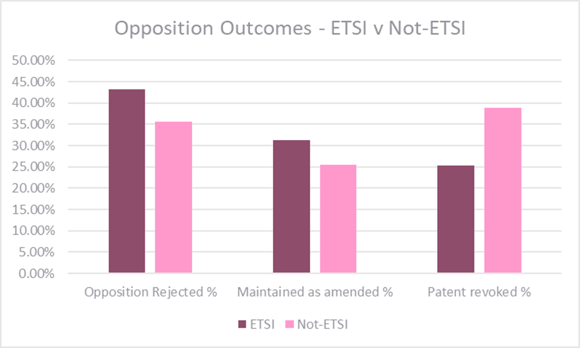This article continues our series of blogs investigating whether or not declaring your patent or application as “essential to a standard” influences the outcome of that patent or application in Europe.
Previous articles have examined pre-grant behaviour, but this article begins exploring post-grant outcomes of SEP v Non-SEP applications. After grant, in Europe, there is the option for third parties to oppose the grant of the European patent on various grounds.
In this blog we are looking at:
Do the opposition rates and outcomes of EP patents that were declared as ETSI differ compared to EP patents that were not?
The source of data for answering this question remains the same: a dataset encompassing all applications filed at the EPO between 1993 and 2021 where they have been classified into the H04 IPC category. From that, we distinguish between those applications which have been declared to ETSI as standards essential (“ETSI”) and those that have not (“Not-ESTI”).
In comparing our datasets, we looked into the opposition rates (the number of oppositions divided by the number of granted patents as a percentage) for patents declared to ETSI (SEPs) compared to patents which were not (non-SEPs). We found that:
- for SEPs the opposition rate is 1.62%; and
- for non-SEPs the opposition rate is 1.20%.
We find then that a SEP is 35% more likely to be opposed over the baseline opposition rate in H04. This is generally expected due to the higher likelihood of commercial value behind patents which have been declared as SEPs.
Turning to the outcomes of these oppositions, we provide the following charts:

In tabular form:
|
|
ETSI outcomes (%) |
Not ETSI outcomes (%) |
|
Opposition rejected |
43.24 |
35.59 |
|
Maintained as amended |
31.35 |
25.45 |
|
Patent revoked |
25.41 |
38.95 |
Interesting then, an opposition against a patent declared to ETSI is more than 13% less likely to result in the complete revocation of the patent than a patent which was not. Furthermore, a patent declared to ETSI is more likely to be maintained as granted (opposition rejected) than a not-ETSI patent.
Overall the outcome of oppositions against ETSI patents (from the point of view of the patentee) would seem to be more favourable than for not-ETSI patents.
What’s to come?
In subsequent blog posts we will investigate who the main players are in the field of SEPs, including who is opposing ETSI declared patents and who is being opposed.
This blog was co-authored by Rebecca Frith and Tom Furnival.
Tom is a Partner and Patent Attorney at Mewburn Ellis. He handles a wide range of patent work, including original drafting, prosecution and opposition, particularly defensive oppositions, in the engineering, electronics, computing and physics fields. Tom also advises on Freedom-to-Operate, infringement issues and registered designs.
Email: tom.furnival@mewburn.com


